Health Service Delivery in Rural or Remote Areas: Case Study Analysis
VerifiedAdded on 2020/05/11
|11
|3291
|139
Report
AI Summary
This report addresses the critical issue of health service delivery in rural and remote areas of Australia. It begins by highlighting the challenges faced by individuals in accessing healthcare due to geographical isolation and sparse populations. The report analyzes the current models of care, focusing on the pivotal role of nurses in providing primary, secondary, and tertiary care, including early intervention, disease prevention, and referrals. It examines the framework for understanding the health problems in rural areas, emphasizing community needs assessment and resource allocation. The report also discusses the importance of government initiatives, such as employing nurses and establishing medical centers, to improve healthcare access and outcomes. The case study illustrates the collaborative efforts of nurses, doctors, and community members in delivering healthcare in remote areas. The report highlights the importance of self-care and community involvement to improve the overall well-being of rural populations. The report concludes by suggesting potential solutions such as increased government funding, more medical facilities, and the importance of qualified medical professionals to ensure that all citizens can access the healthcare that they need.
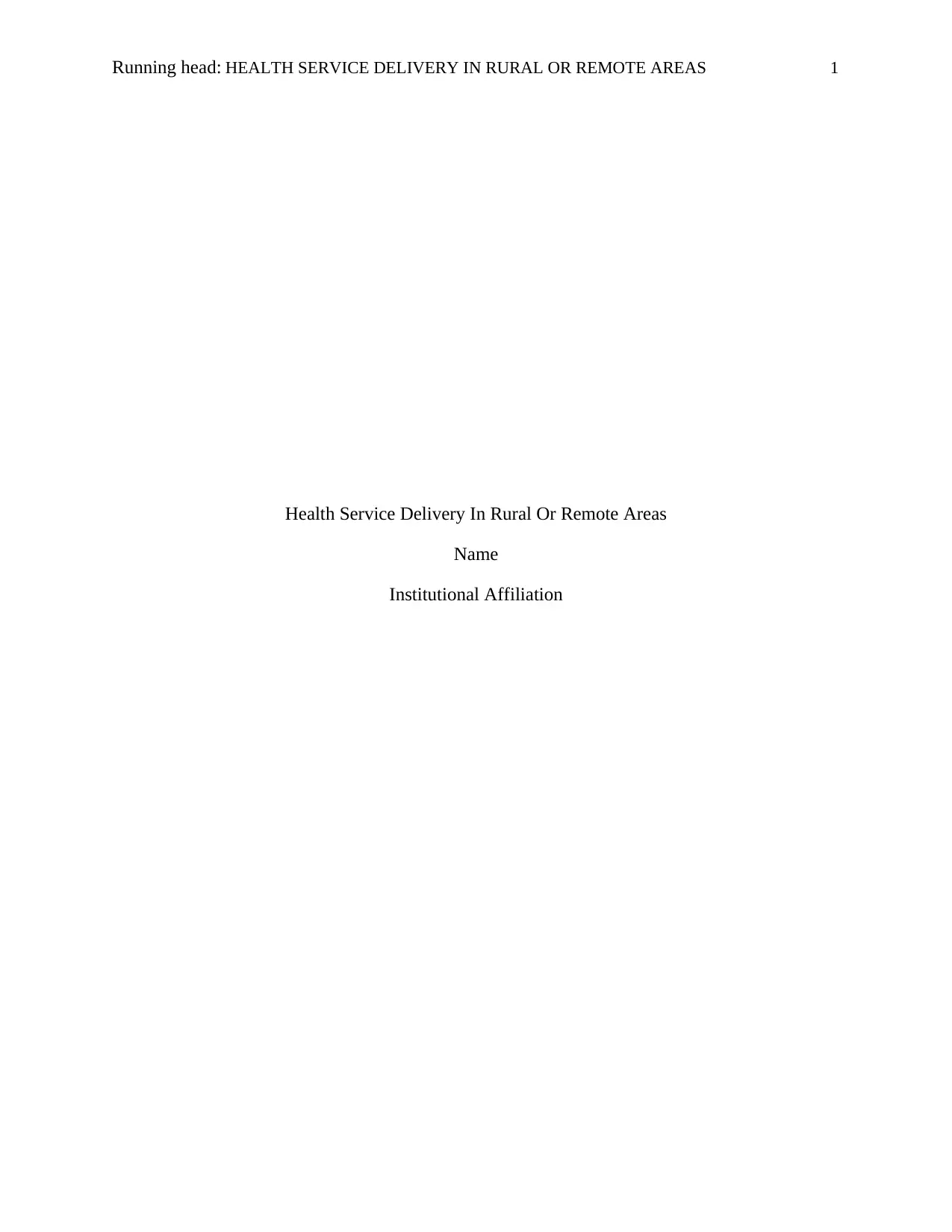
Running head: HEALTH SERVICE DELIVERY IN RURAL OR REMOTE AREAS 1
Health Service Delivery In Rural Or Remote Areas
Name
Institutional Affiliation
Health Service Delivery In Rural Or Remote Areas
Name
Institutional Affiliation
Paraphrase This Document
Need a fresh take? Get an instant paraphrase of this document with our AI Paraphraser
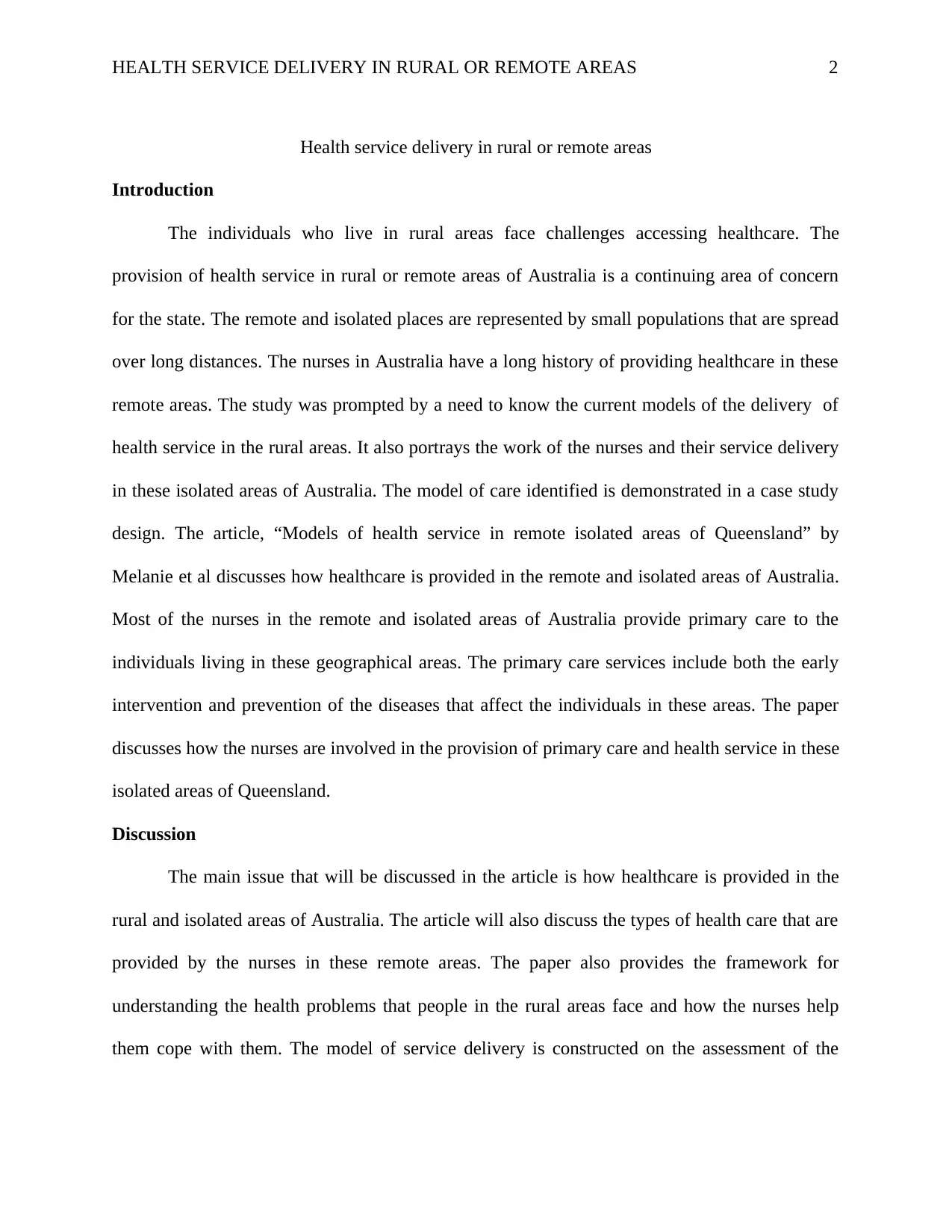
HEALTH SERVICE DELIVERY IN RURAL OR REMOTE AREAS 2
Health service delivery in rural or remote areas
Introduction
The individuals who live in rural areas face challenges accessing healthcare. The
provision of health service in rural or remote areas of Australia is a continuing area of concern
for the state. The remote and isolated places are represented by small populations that are spread
over long distances. The nurses in Australia have a long history of providing healthcare in these
remote areas. The study was prompted by a need to know the current models of the delivery of
health service in the rural areas. It also portrays the work of the nurses and their service delivery
in these isolated areas of Australia. The model of care identified is demonstrated in a case study
design. The article, “Models of health service in remote isolated areas of Queensland” by
Melanie et al discusses how healthcare is provided in the remote and isolated areas of Australia.
Most of the nurses in the remote and isolated areas of Australia provide primary care to the
individuals living in these geographical areas. The primary care services include both the early
intervention and prevention of the diseases that affect the individuals in these areas. The paper
discusses how the nurses are involved in the provision of primary care and health service in these
isolated areas of Queensland.
Discussion
The main issue that will be discussed in the article is how healthcare is provided in the
rural and isolated areas of Australia. The article will also discuss the types of health care that are
provided by the nurses in these remote areas. The paper also provides the framework for
understanding the health problems that people in the rural areas face and how the nurses help
them cope with them. The model of service delivery is constructed on the assessment of the
Health service delivery in rural or remote areas
Introduction
The individuals who live in rural areas face challenges accessing healthcare. The
provision of health service in rural or remote areas of Australia is a continuing area of concern
for the state. The remote and isolated places are represented by small populations that are spread
over long distances. The nurses in Australia have a long history of providing healthcare in these
remote areas. The study was prompted by a need to know the current models of the delivery of
health service in the rural areas. It also portrays the work of the nurses and their service delivery
in these isolated areas of Australia. The model of care identified is demonstrated in a case study
design. The article, “Models of health service in remote isolated areas of Queensland” by
Melanie et al discusses how healthcare is provided in the remote and isolated areas of Australia.
Most of the nurses in the remote and isolated areas of Australia provide primary care to the
individuals living in these geographical areas. The primary care services include both the early
intervention and prevention of the diseases that affect the individuals in these areas. The paper
discusses how the nurses are involved in the provision of primary care and health service in these
isolated areas of Queensland.
Discussion
The main issue that will be discussed in the article is how healthcare is provided in the
rural and isolated areas of Australia. The article will also discuss the types of health care that are
provided by the nurses in these remote areas. The paper also provides the framework for
understanding the health problems that people in the rural areas face and how the nurses help
them cope with them. The model of service delivery is constructed on the assessment of the
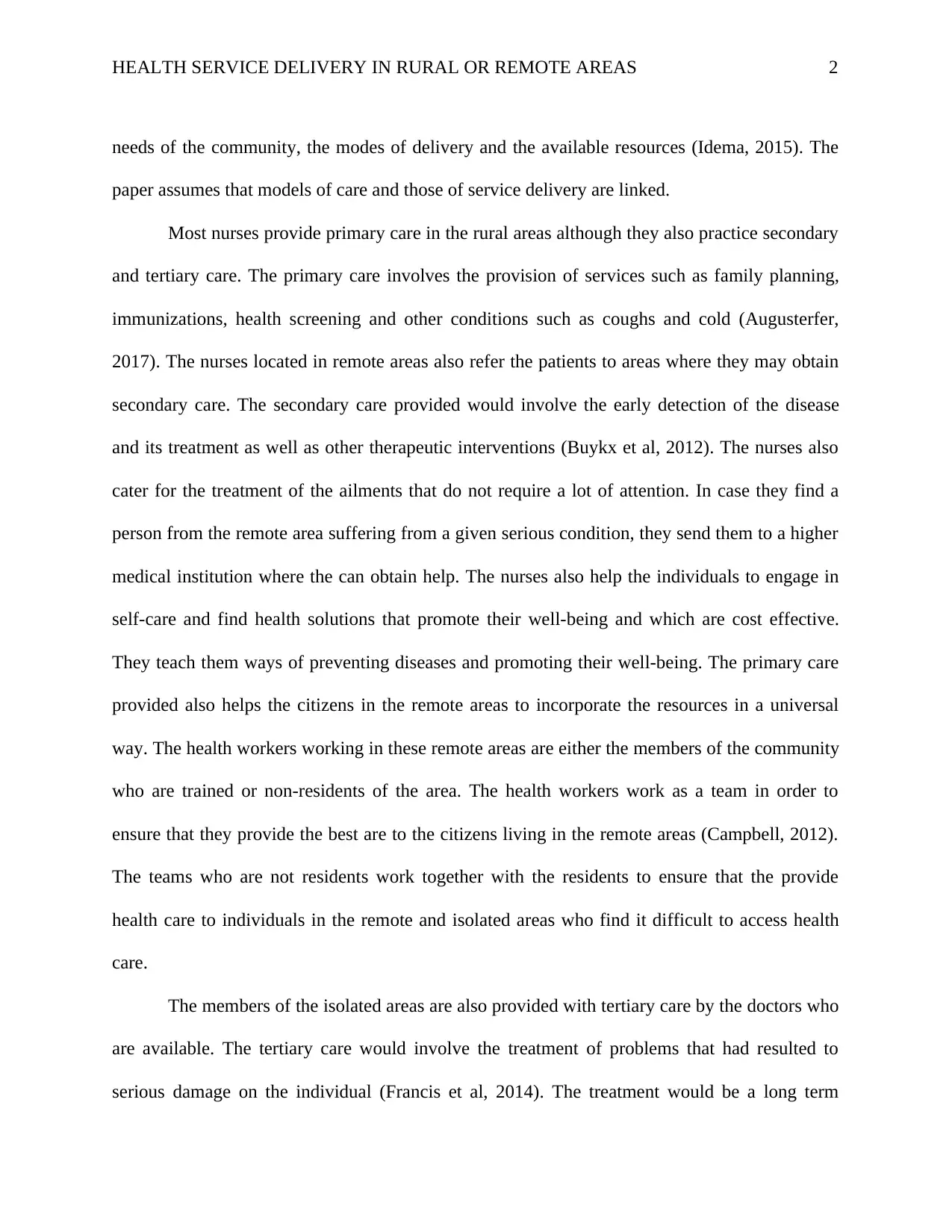
HEALTH SERVICE DELIVERY IN RURAL OR REMOTE AREAS 2
needs of the community, the modes of delivery and the available resources (Idema, 2015). The
paper assumes that models of care and those of service delivery are linked.
Most nurses provide primary care in the rural areas although they also practice secondary
and tertiary care. The primary care involves the provision of services such as family planning,
immunizations, health screening and other conditions such as coughs and cold (Augusterfer,
2017). The nurses located in remote areas also refer the patients to areas where they may obtain
secondary care. The secondary care provided would involve the early detection of the disease
and its treatment as well as other therapeutic interventions (Buykx et al, 2012). The nurses also
cater for the treatment of the ailments that do not require a lot of attention. In case they find a
person from the remote area suffering from a given serious condition, they send them to a higher
medical institution where the can obtain help. The nurses also help the individuals to engage in
self-care and find health solutions that promote their well-being and which are cost effective.
They teach them ways of preventing diseases and promoting their well-being. The primary care
provided also helps the citizens in the remote areas to incorporate the resources in a universal
way. The health workers working in these remote areas are either the members of the community
who are trained or non-residents of the area. The health workers work as a team in order to
ensure that they provide the best are to the citizens living in the remote areas (Campbell, 2012).
The teams who are not residents work together with the residents to ensure that the provide
health care to individuals in the remote and isolated areas who find it difficult to access health
care.
The members of the isolated areas are also provided with tertiary care by the doctors who
are available. The tertiary care would involve the treatment of problems that had resulted to
serious damage on the individual (Francis et al, 2014). The treatment would be a long term
needs of the community, the modes of delivery and the available resources (Idema, 2015). The
paper assumes that models of care and those of service delivery are linked.
Most nurses provide primary care in the rural areas although they also practice secondary
and tertiary care. The primary care involves the provision of services such as family planning,
immunizations, health screening and other conditions such as coughs and cold (Augusterfer,
2017). The nurses located in remote areas also refer the patients to areas where they may obtain
secondary care. The secondary care provided would involve the early detection of the disease
and its treatment as well as other therapeutic interventions (Buykx et al, 2012). The nurses also
cater for the treatment of the ailments that do not require a lot of attention. In case they find a
person from the remote area suffering from a given serious condition, they send them to a higher
medical institution where the can obtain help. The nurses also help the individuals to engage in
self-care and find health solutions that promote their well-being and which are cost effective.
They teach them ways of preventing diseases and promoting their well-being. The primary care
provided also helps the citizens in the remote areas to incorporate the resources in a universal
way. The health workers working in these remote areas are either the members of the community
who are trained or non-residents of the area. The health workers work as a team in order to
ensure that they provide the best are to the citizens living in the remote areas (Campbell, 2012).
The teams who are not residents work together with the residents to ensure that the provide
health care to individuals in the remote and isolated areas who find it difficult to access health
care.
The members of the isolated areas are also provided with tertiary care by the doctors who
are available. The tertiary care would involve the treatment of problems that had resulted to
serious damage on the individual (Francis et al, 2014). The treatment would be a long term
⊘ This is a preview!⊘
Do you want full access?
Subscribe today to unlock all pages.

Trusted by 1+ million students worldwide
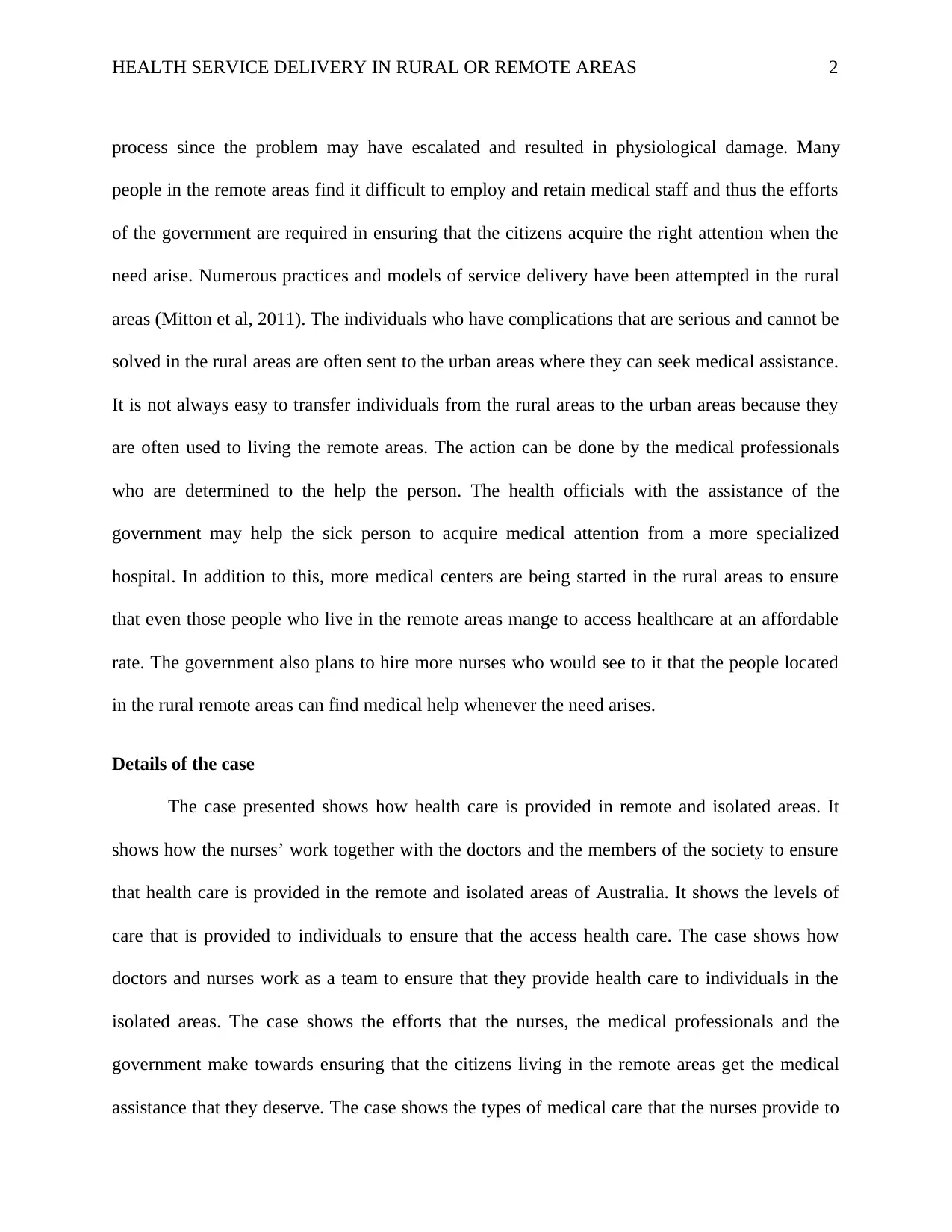
HEALTH SERVICE DELIVERY IN RURAL OR REMOTE AREAS 2
process since the problem may have escalated and resulted in physiological damage. Many
people in the remote areas find it difficult to employ and retain medical staff and thus the efforts
of the government are required in ensuring that the citizens acquire the right attention when the
need arise. Numerous practices and models of service delivery have been attempted in the rural
areas (Mitton et al, 2011). The individuals who have complications that are serious and cannot be
solved in the rural areas are often sent to the urban areas where they can seek medical assistance.
It is not always easy to transfer individuals from the rural areas to the urban areas because they
are often used to living the remote areas. The action can be done by the medical professionals
who are determined to the help the person. The health officials with the assistance of the
government may help the sick person to acquire medical attention from a more specialized
hospital. In addition to this, more medical centers are being started in the rural areas to ensure
that even those people who live in the remote areas mange to access healthcare at an affordable
rate. The government also plans to hire more nurses who would see to it that the people located
in the rural remote areas can find medical help whenever the need arises.
Details of the case
The case presented shows how health care is provided in remote and isolated areas. It
shows how the nurses’ work together with the doctors and the members of the society to ensure
that health care is provided in the remote and isolated areas of Australia. It shows the levels of
care that is provided to individuals to ensure that the access health care. The case shows how
doctors and nurses work as a team to ensure that they provide health care to individuals in the
isolated areas. The case shows the efforts that the nurses, the medical professionals and the
government make towards ensuring that the citizens living in the remote areas get the medical
assistance that they deserve. The case shows the types of medical care that the nurses provide to
process since the problem may have escalated and resulted in physiological damage. Many
people in the remote areas find it difficult to employ and retain medical staff and thus the efforts
of the government are required in ensuring that the citizens acquire the right attention when the
need arise. Numerous practices and models of service delivery have been attempted in the rural
areas (Mitton et al, 2011). The individuals who have complications that are serious and cannot be
solved in the rural areas are often sent to the urban areas where they can seek medical assistance.
It is not always easy to transfer individuals from the rural areas to the urban areas because they
are often used to living the remote areas. The action can be done by the medical professionals
who are determined to the help the person. The health officials with the assistance of the
government may help the sick person to acquire medical attention from a more specialized
hospital. In addition to this, more medical centers are being started in the rural areas to ensure
that even those people who live in the remote areas mange to access healthcare at an affordable
rate. The government also plans to hire more nurses who would see to it that the people located
in the rural remote areas can find medical help whenever the need arises.
Details of the case
The case presented shows how health care is provided in remote and isolated areas. It
shows how the nurses’ work together with the doctors and the members of the society to ensure
that health care is provided in the remote and isolated areas of Australia. It shows the levels of
care that is provided to individuals to ensure that the access health care. The case shows how
doctors and nurses work as a team to ensure that they provide health care to individuals in the
isolated areas. The case shows the efforts that the nurses, the medical professionals and the
government make towards ensuring that the citizens living in the remote areas get the medical
assistance that they deserve. The case shows the types of medical care that the nurses provide to
Paraphrase This Document
Need a fresh take? Get an instant paraphrase of this document with our AI Paraphraser
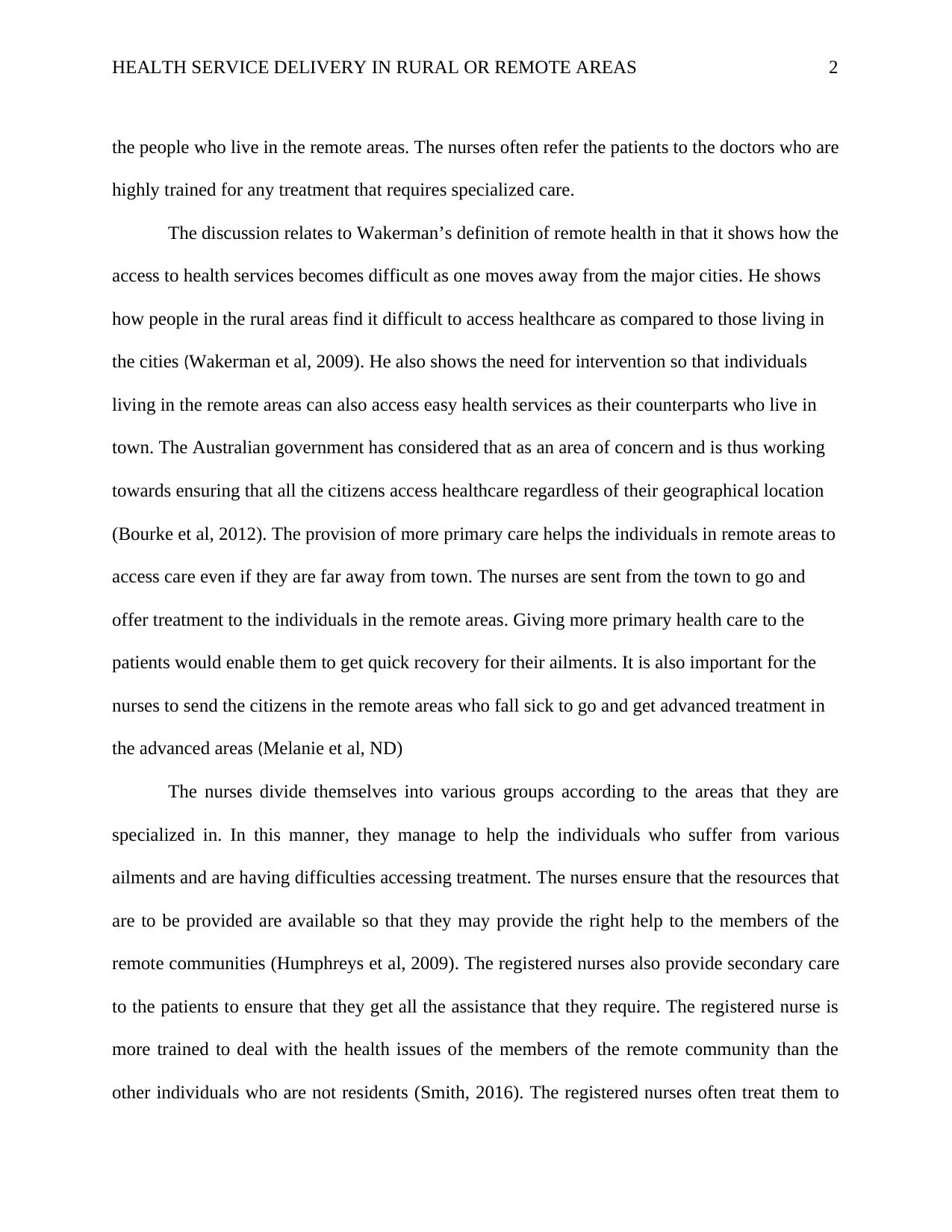
HEALTH SERVICE DELIVERY IN RURAL OR REMOTE AREAS 2
the people who live in the remote areas. The nurses often refer the patients to the doctors who are
highly trained for any treatment that requires specialized care.
The discussion relates to Wakerman’s definition of remote health in that it shows how the
access to health services becomes difficult as one moves away from the major cities. He shows
how people in the rural areas find it difficult to access healthcare as compared to those living in
the cities (Wakerman et al, 2009). He also shows the need for intervention so that individuals
living in the remote areas can also access easy health services as their counterparts who live in
town. The Australian government has considered that as an area of concern and is thus working
towards ensuring that all the citizens access healthcare regardless of their geographical location
(Bourke et al, 2012). The provision of more primary care helps the individuals in remote areas to
access care even if they are far away from town. The nurses are sent from the town to go and
offer treatment to the individuals in the remote areas. Giving more primary health care to the
patients would enable them to get quick recovery for their ailments. It is also important for the
nurses to send the citizens in the remote areas who fall sick to go and get advanced treatment in
the advanced areas (Melanie et al, ND)
The nurses divide themselves into various groups according to the areas that they are
specialized in. In this manner, they manage to help the individuals who suffer from various
ailments and are having difficulties accessing treatment. The nurses ensure that the resources that
are to be provided are available so that they may provide the right help to the members of the
remote communities (Humphreys et al, 2009). The registered nurses also provide secondary care
to the patients to ensure that they get all the assistance that they require. The registered nurse is
more trained to deal with the health issues of the members of the remote community than the
other individuals who are not residents (Smith, 2016). The registered nurses often treat them to
the people who live in the remote areas. The nurses often refer the patients to the doctors who are
highly trained for any treatment that requires specialized care.
The discussion relates to Wakerman’s definition of remote health in that it shows how the
access to health services becomes difficult as one moves away from the major cities. He shows
how people in the rural areas find it difficult to access healthcare as compared to those living in
the cities (Wakerman et al, 2009). He also shows the need for intervention so that individuals
living in the remote areas can also access easy health services as their counterparts who live in
town. The Australian government has considered that as an area of concern and is thus working
towards ensuring that all the citizens access healthcare regardless of their geographical location
(Bourke et al, 2012). The provision of more primary care helps the individuals in remote areas to
access care even if they are far away from town. The nurses are sent from the town to go and
offer treatment to the individuals in the remote areas. Giving more primary health care to the
patients would enable them to get quick recovery for their ailments. It is also important for the
nurses to send the citizens in the remote areas who fall sick to go and get advanced treatment in
the advanced areas (Melanie et al, ND)
The nurses divide themselves into various groups according to the areas that they are
specialized in. In this manner, they manage to help the individuals who suffer from various
ailments and are having difficulties accessing treatment. The nurses ensure that the resources that
are to be provided are available so that they may provide the right help to the members of the
remote communities (Humphreys et al, 2009). The registered nurses also provide secondary care
to the patients to ensure that they get all the assistance that they require. The registered nurse is
more trained to deal with the health issues of the members of the remote community than the
other individuals who are not residents (Smith, 2016). The registered nurses often treat them to
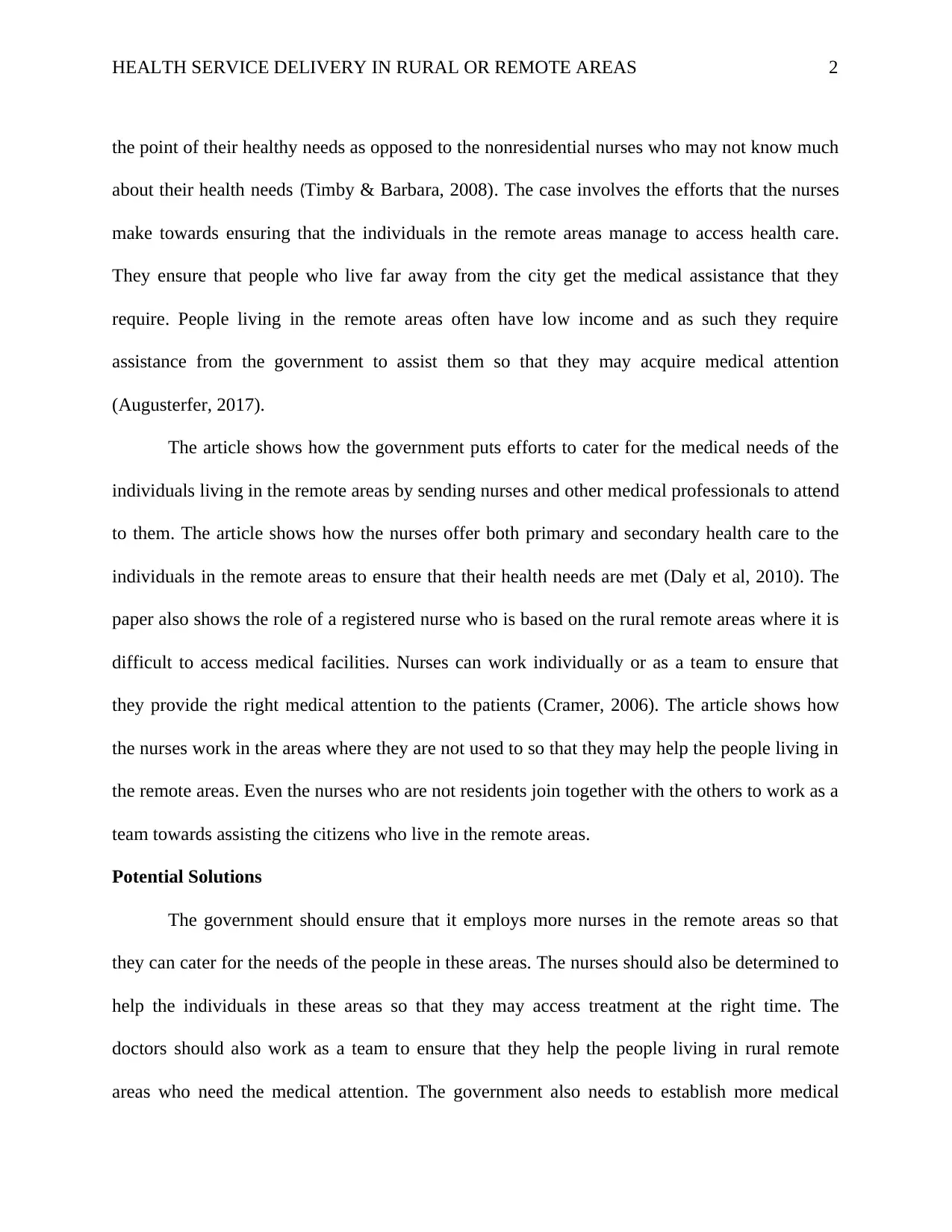
HEALTH SERVICE DELIVERY IN RURAL OR REMOTE AREAS 2
the point of their healthy needs as opposed to the nonresidential nurses who may not know much
about their health needs (Timby & Barbara, 2008). The case involves the efforts that the nurses
make towards ensuring that the individuals in the remote areas manage to access health care.
They ensure that people who live far away from the city get the medical assistance that they
require. People living in the remote areas often have low income and as such they require
assistance from the government to assist them so that they may acquire medical attention
(Augusterfer, 2017).
The article shows how the government puts efforts to cater for the medical needs of the
individuals living in the remote areas by sending nurses and other medical professionals to attend
to them. The article shows how the nurses offer both primary and secondary health care to the
individuals in the remote areas to ensure that their health needs are met (Daly et al, 2010). The
paper also shows the role of a registered nurse who is based on the rural remote areas where it is
difficult to access medical facilities. Nurses can work individually or as a team to ensure that
they provide the right medical attention to the patients (Cramer, 2006). The article shows how
the nurses work in the areas where they are not used to so that they may help the people living in
the remote areas. Even the nurses who are not residents join together with the others to work as a
team towards assisting the citizens who live in the remote areas.
Potential Solutions
The government should ensure that it employs more nurses in the remote areas so that
they can cater for the needs of the people in these areas. The nurses should also be determined to
help the individuals in these areas so that they may access treatment at the right time. The
doctors should also work as a team to ensure that they help the people living in rural remote
areas who need the medical attention. The government also needs to establish more medical
the point of their healthy needs as opposed to the nonresidential nurses who may not know much
about their health needs (Timby & Barbara, 2008). The case involves the efforts that the nurses
make towards ensuring that the individuals in the remote areas manage to access health care.
They ensure that people who live far away from the city get the medical assistance that they
require. People living in the remote areas often have low income and as such they require
assistance from the government to assist them so that they may acquire medical attention
(Augusterfer, 2017).
The article shows how the government puts efforts to cater for the medical needs of the
individuals living in the remote areas by sending nurses and other medical professionals to attend
to them. The article shows how the nurses offer both primary and secondary health care to the
individuals in the remote areas to ensure that their health needs are met (Daly et al, 2010). The
paper also shows the role of a registered nurse who is based on the rural remote areas where it is
difficult to access medical facilities. Nurses can work individually or as a team to ensure that
they provide the right medical attention to the patients (Cramer, 2006). The article shows how
the nurses work in the areas where they are not used to so that they may help the people living in
the remote areas. Even the nurses who are not residents join together with the others to work as a
team towards assisting the citizens who live in the remote areas.
Potential Solutions
The government should ensure that it employs more nurses in the remote areas so that
they can cater for the needs of the people in these areas. The nurses should also be determined to
help the individuals in these areas so that they may access treatment at the right time. The
doctors should also work as a team to ensure that they help the people living in rural remote
areas who need the medical attention. The government also needs to establish more medical
⊘ This is a preview!⊘
Do you want full access?
Subscribe today to unlock all pages.

Trusted by 1+ million students worldwide
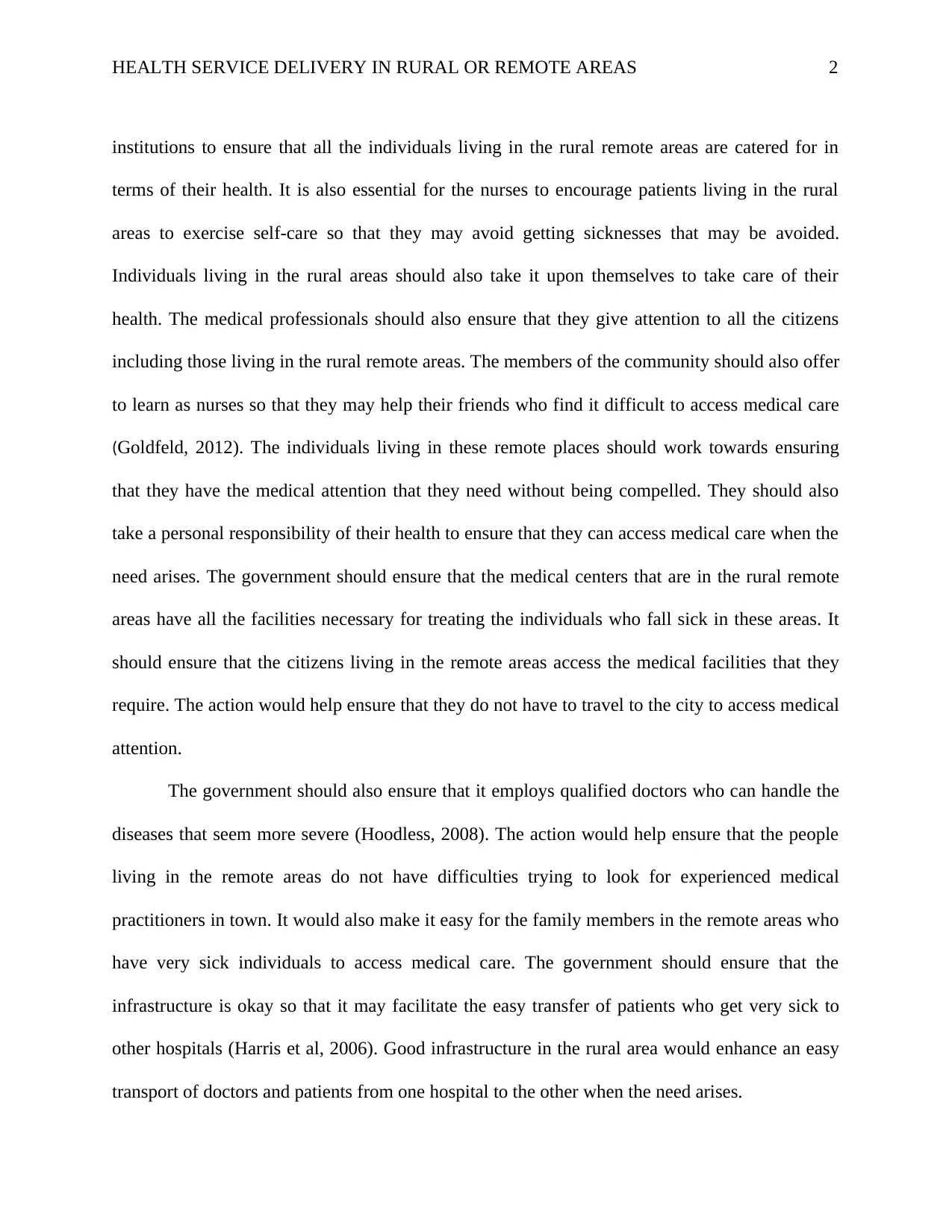
HEALTH SERVICE DELIVERY IN RURAL OR REMOTE AREAS 2
institutions to ensure that all the individuals living in the rural remote areas are catered for in
terms of their health. It is also essential for the nurses to encourage patients living in the rural
areas to exercise self-care so that they may avoid getting sicknesses that may be avoided.
Individuals living in the rural areas should also take it upon themselves to take care of their
health. The medical professionals should also ensure that they give attention to all the citizens
including those living in the rural remote areas. The members of the community should also offer
to learn as nurses so that they may help their friends who find it difficult to access medical care
(Goldfeld, 2012). The individuals living in these remote places should work towards ensuring
that they have the medical attention that they need without being compelled. They should also
take a personal responsibility of their health to ensure that they can access medical care when the
need arises. The government should ensure that the medical centers that are in the rural remote
areas have all the facilities necessary for treating the individuals who fall sick in these areas. It
should ensure that the citizens living in the remote areas access the medical facilities that they
require. The action would help ensure that they do not have to travel to the city to access medical
attention.
The government should also ensure that it employs qualified doctors who can handle the
diseases that seem more severe (Hoodless, 2008). The action would help ensure that the people
living in the remote areas do not have difficulties trying to look for experienced medical
practitioners in town. It would also make it easy for the family members in the remote areas who
have very sick individuals to access medical care. The government should ensure that the
infrastructure is okay so that it may facilitate the easy transfer of patients who get very sick to
other hospitals (Harris et al, 2006). Good infrastructure in the rural area would enhance an easy
transport of doctors and patients from one hospital to the other when the need arises.
institutions to ensure that all the individuals living in the rural remote areas are catered for in
terms of their health. It is also essential for the nurses to encourage patients living in the rural
areas to exercise self-care so that they may avoid getting sicknesses that may be avoided.
Individuals living in the rural areas should also take it upon themselves to take care of their
health. The medical professionals should also ensure that they give attention to all the citizens
including those living in the rural remote areas. The members of the community should also offer
to learn as nurses so that they may help their friends who find it difficult to access medical care
(Goldfeld, 2012). The individuals living in these remote places should work towards ensuring
that they have the medical attention that they need without being compelled. They should also
take a personal responsibility of their health to ensure that they can access medical care when the
need arises. The government should ensure that the medical centers that are in the rural remote
areas have all the facilities necessary for treating the individuals who fall sick in these areas. It
should ensure that the citizens living in the remote areas access the medical facilities that they
require. The action would help ensure that they do not have to travel to the city to access medical
attention.
The government should also ensure that it employs qualified doctors who can handle the
diseases that seem more severe (Hoodless, 2008). The action would help ensure that the people
living in the remote areas do not have difficulties trying to look for experienced medical
practitioners in town. It would also make it easy for the family members in the remote areas who
have very sick individuals to access medical care. The government should ensure that the
infrastructure is okay so that it may facilitate the easy transfer of patients who get very sick to
other hospitals (Harris et al, 2006). Good infrastructure in the rural area would enhance an easy
transport of doctors and patients from one hospital to the other when the need arises.
Paraphrase This Document
Need a fresh take? Get an instant paraphrase of this document with our AI Paraphraser
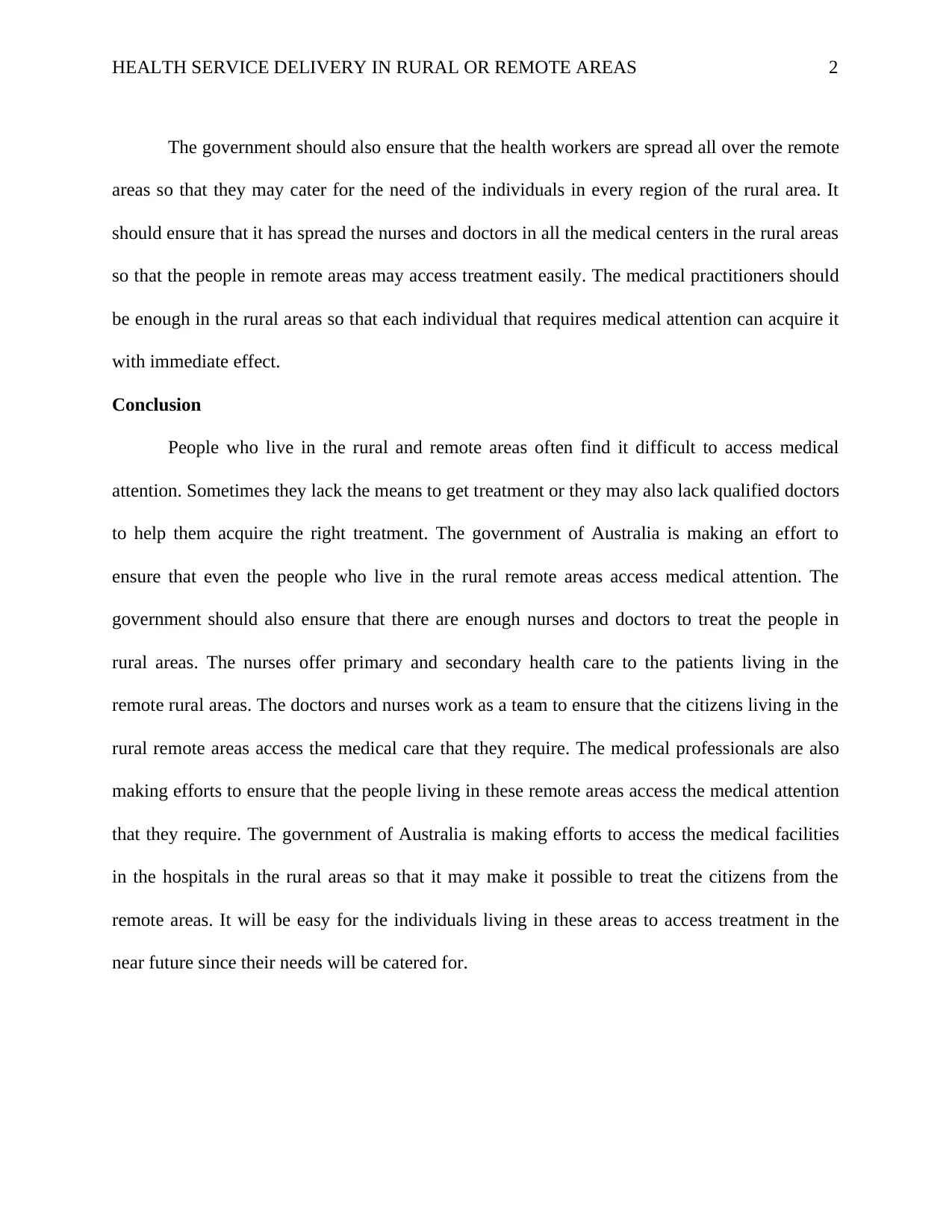
HEALTH SERVICE DELIVERY IN RURAL OR REMOTE AREAS 2
The government should also ensure that the health workers are spread all over the remote
areas so that they may cater for the need of the individuals in every region of the rural area. It
should ensure that it has spread the nurses and doctors in all the medical centers in the rural areas
so that the people in remote areas may access treatment easily. The medical practitioners should
be enough in the rural areas so that each individual that requires medical attention can acquire it
with immediate effect.
Conclusion
People who live in the rural and remote areas often find it difficult to access medical
attention. Sometimes they lack the means to get treatment or they may also lack qualified doctors
to help them acquire the right treatment. The government of Australia is making an effort to
ensure that even the people who live in the rural remote areas access medical attention. The
government should also ensure that there are enough nurses and doctors to treat the people in
rural areas. The nurses offer primary and secondary health care to the patients living in the
remote rural areas. The doctors and nurses work as a team to ensure that the citizens living in the
rural remote areas access the medical care that they require. The medical professionals are also
making efforts to ensure that the people living in these remote areas access the medical attention
that they require. The government of Australia is making efforts to access the medical facilities
in the hospitals in the rural areas so that it may make it possible to treat the citizens from the
remote areas. It will be easy for the individuals living in these areas to access treatment in the
near future since their needs will be catered for.
The government should also ensure that the health workers are spread all over the remote
areas so that they may cater for the need of the individuals in every region of the rural area. It
should ensure that it has spread the nurses and doctors in all the medical centers in the rural areas
so that the people in remote areas may access treatment easily. The medical practitioners should
be enough in the rural areas so that each individual that requires medical attention can acquire it
with immediate effect.
Conclusion
People who live in the rural and remote areas often find it difficult to access medical
attention. Sometimes they lack the means to get treatment or they may also lack qualified doctors
to help them acquire the right treatment. The government of Australia is making an effort to
ensure that even the people who live in the rural remote areas access medical attention. The
government should also ensure that there are enough nurses and doctors to treat the people in
rural areas. The nurses offer primary and secondary health care to the patients living in the
remote rural areas. The doctors and nurses work as a team to ensure that the citizens living in the
rural remote areas access the medical care that they require. The medical professionals are also
making efforts to ensure that the people living in these remote areas access the medical attention
that they require. The government of Australia is making efforts to access the medical facilities
in the hospitals in the rural areas so that it may make it possible to treat the citizens from the
remote areas. It will be easy for the individuals living in these areas to access treatment in the
near future since their needs will be catered for.
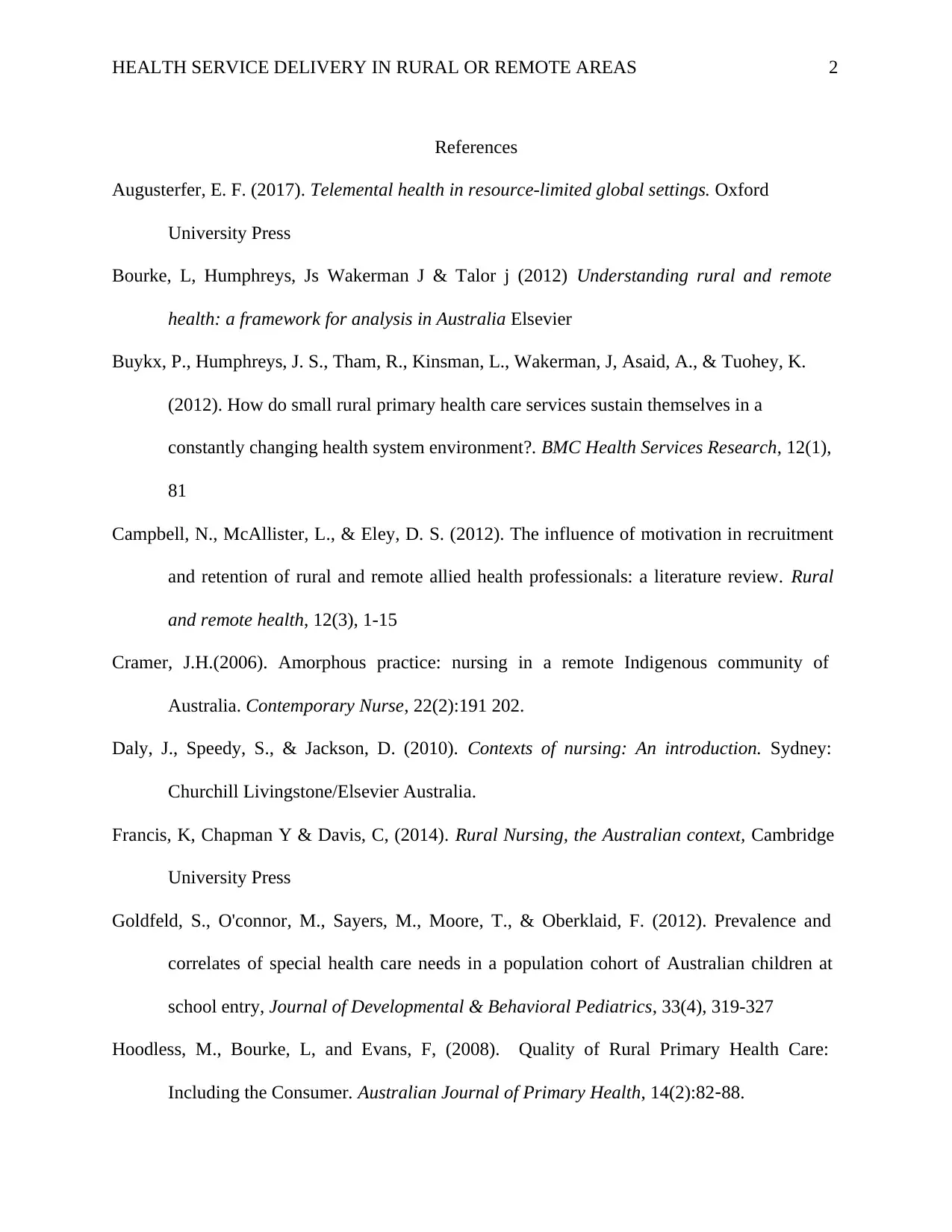
HEALTH SERVICE DELIVERY IN RURAL OR REMOTE AREAS 2
References
Augusterfer, E. F. (2017). Telemental health in resource-limited global settings. Oxford
University Press
Bourke, L, Humphreys, Js Wakerman J & Talor j (2012) Understanding rural and remote
health: a framework for analysis in Australia Elsevier
Buykx, P., Humphreys, J. S., Tham, R., Kinsman, L., Wakerman, J, Asaid, A., & Tuohey, K.
(2012). How do small rural primary health care services sustain themselves in a
constantly changing health system environment?. BMC Health Services Research, 12(1),
81
Campbell, N., McAllister, L., & Eley, D. S. (2012). The influence of motivation in recruitment
and retention of rural and remote allied health professionals: a literature review. Rural
and remote health, 12(3), 1-15
Cramer, J.H.(2006). Amorphous practice: nursing in a remote Indigenous community of
Australia. Contemporary Nurse, 22(2):191 202.
Daly, J., Speedy, S., & Jackson, D. (2010). Contexts of nursing: An introduction. Sydney:
Churchill Livingstone/Elsevier Australia.
Francis, K, Chapman Y & Davis, C, (2014). Rural Nursing, the Australian context, Cambridge
University Press
Goldfeld, S., O'connor, M., Sayers, M., Moore, T., & Oberklaid, F. (2012). Prevalence and
correlates of special health care needs in a population cohort of Australian children at
school entry, Journal of Developmental & Behavioral Pediatrics, 33(4), 319-327
Hoodless, M., Bourke, L, and Evans, F, (2008). Quality of Rural Primary Health Care:
Including the Consumer. Australian Journal of Primary Health, 14(2):82-88.
References
Augusterfer, E. F. (2017). Telemental health in resource-limited global settings. Oxford
University Press
Bourke, L, Humphreys, Js Wakerman J & Talor j (2012) Understanding rural and remote
health: a framework for analysis in Australia Elsevier
Buykx, P., Humphreys, J. S., Tham, R., Kinsman, L., Wakerman, J, Asaid, A., & Tuohey, K.
(2012). How do small rural primary health care services sustain themselves in a
constantly changing health system environment?. BMC Health Services Research, 12(1),
81
Campbell, N., McAllister, L., & Eley, D. S. (2012). The influence of motivation in recruitment
and retention of rural and remote allied health professionals: a literature review. Rural
and remote health, 12(3), 1-15
Cramer, J.H.(2006). Amorphous practice: nursing in a remote Indigenous community of
Australia. Contemporary Nurse, 22(2):191 202.
Daly, J., Speedy, S., & Jackson, D. (2010). Contexts of nursing: An introduction. Sydney:
Churchill Livingstone/Elsevier Australia.
Francis, K, Chapman Y & Davis, C, (2014). Rural Nursing, the Australian context, Cambridge
University Press
Goldfeld, S., O'connor, M., Sayers, M., Moore, T., & Oberklaid, F. (2012). Prevalence and
correlates of special health care needs in a population cohort of Australian children at
school entry, Journal of Developmental & Behavioral Pediatrics, 33(4), 319-327
Hoodless, M., Bourke, L, and Evans, F, (2008). Quality of Rural Primary Health Care:
Including the Consumer. Australian Journal of Primary Health, 14(2):82-88.
⊘ This is a preview!⊘
Do you want full access?
Subscribe today to unlock all pages.

Trusted by 1+ million students worldwide
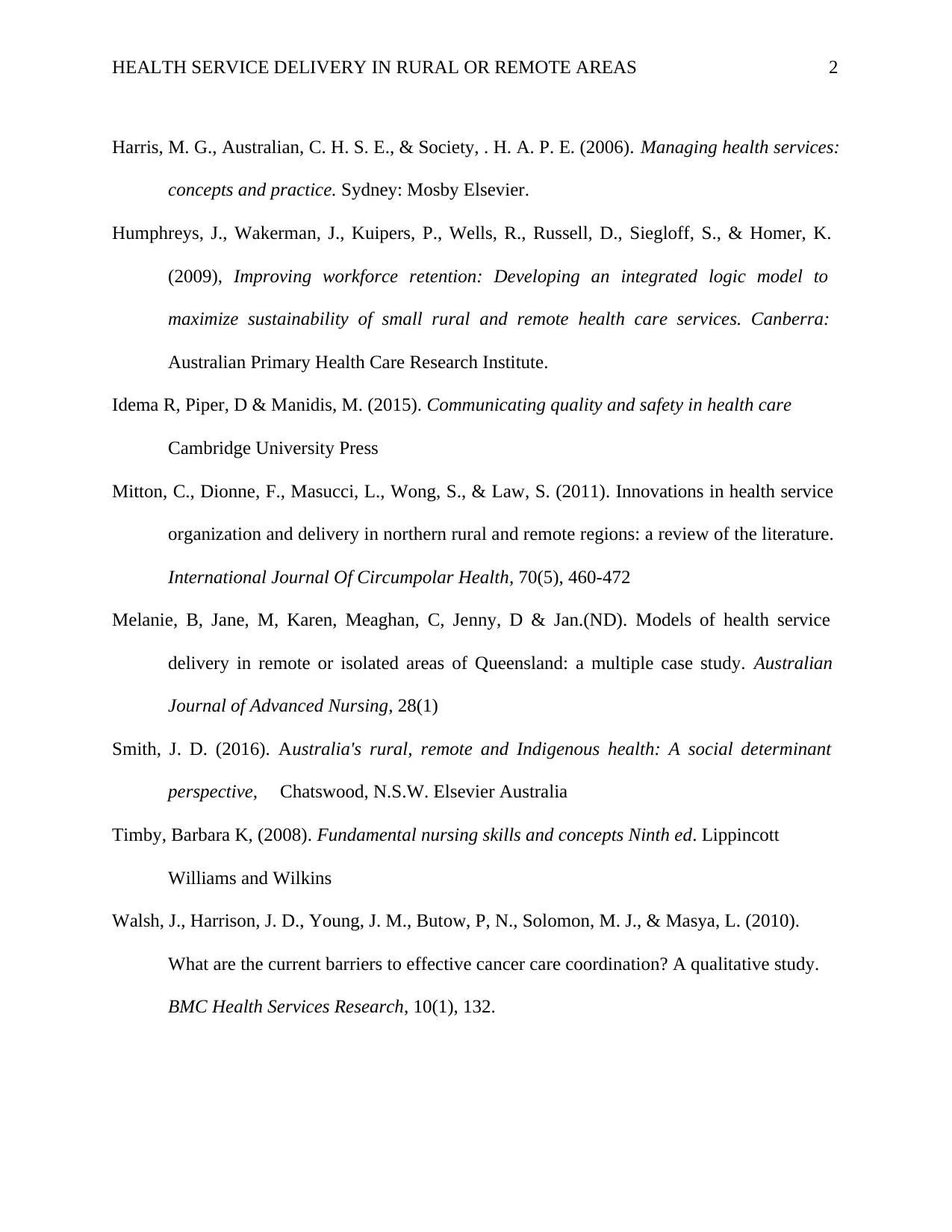
HEALTH SERVICE DELIVERY IN RURAL OR REMOTE AREAS 2
Harris, M. G., Australian, C. H. S. E., & Society, . H. A. P. E. (2006). Managing health services:
concepts and practice. Sydney: Mosby Elsevier.
Humphreys, J., Wakerman, J., Kuipers, P., Wells, R., Russell, D., Siegloff, S., & Homer, K.
(2009), Improving workforce retention: Developing an integrated logic model to
maximize sustainability of small rural and remote health care services. Canberra:
Australian Primary Health Care Research Institute.
Idema R, Piper, D & Manidis, M. (2015). Communicating quality and safety in health care
Cambridge University Press
Mitton, C., Dionne, F., Masucci, L., Wong, S., & Law, S. (2011). Innovations in health service
organization and delivery in northern rural and remote regions: a review of the literature.
International Journal Of Circumpolar Health, 70(5), 460-472
Melanie, B, Jane, M, Karen, Meaghan, C, Jenny, D & Jan.(ND). Models of health service
delivery in remote or isolated areas of Queensland: a multiple case study. Australian
Journal of Advanced Nursing, 28(1)
Smith, J. D. (2016). Australia's rural, remote and Indigenous health: A social determinant
perspective, Chatswood, N.S.W. Elsevier Australia
Timby, Barbara K, (2008). Fundamental nursing skills and concepts Ninth ed. Lippincott
Williams and Wilkins
Walsh, J., Harrison, J. D., Young, J. M., Butow, P, N., Solomon, M. J., & Masya, L. (2010).
What are the current barriers to effective cancer care coordination? A qualitative study.
BMC Health Services Research, 10(1), 132.
Harris, M. G., Australian, C. H. S. E., & Society, . H. A. P. E. (2006). Managing health services:
concepts and practice. Sydney: Mosby Elsevier.
Humphreys, J., Wakerman, J., Kuipers, P., Wells, R., Russell, D., Siegloff, S., & Homer, K.
(2009), Improving workforce retention: Developing an integrated logic model to
maximize sustainability of small rural and remote health care services. Canberra:
Australian Primary Health Care Research Institute.
Idema R, Piper, D & Manidis, M. (2015). Communicating quality and safety in health care
Cambridge University Press
Mitton, C., Dionne, F., Masucci, L., Wong, S., & Law, S. (2011). Innovations in health service
organization and delivery in northern rural and remote regions: a review of the literature.
International Journal Of Circumpolar Health, 70(5), 460-472
Melanie, B, Jane, M, Karen, Meaghan, C, Jenny, D & Jan.(ND). Models of health service
delivery in remote or isolated areas of Queensland: a multiple case study. Australian
Journal of Advanced Nursing, 28(1)
Smith, J. D. (2016). Australia's rural, remote and Indigenous health: A social determinant
perspective, Chatswood, N.S.W. Elsevier Australia
Timby, Barbara K, (2008). Fundamental nursing skills and concepts Ninth ed. Lippincott
Williams and Wilkins
Walsh, J., Harrison, J. D., Young, J. M., Butow, P, N., Solomon, M. J., & Masya, L. (2010).
What are the current barriers to effective cancer care coordination? A qualitative study.
BMC Health Services Research, 10(1), 132.
Paraphrase This Document
Need a fresh take? Get an instant paraphrase of this document with our AI Paraphraser
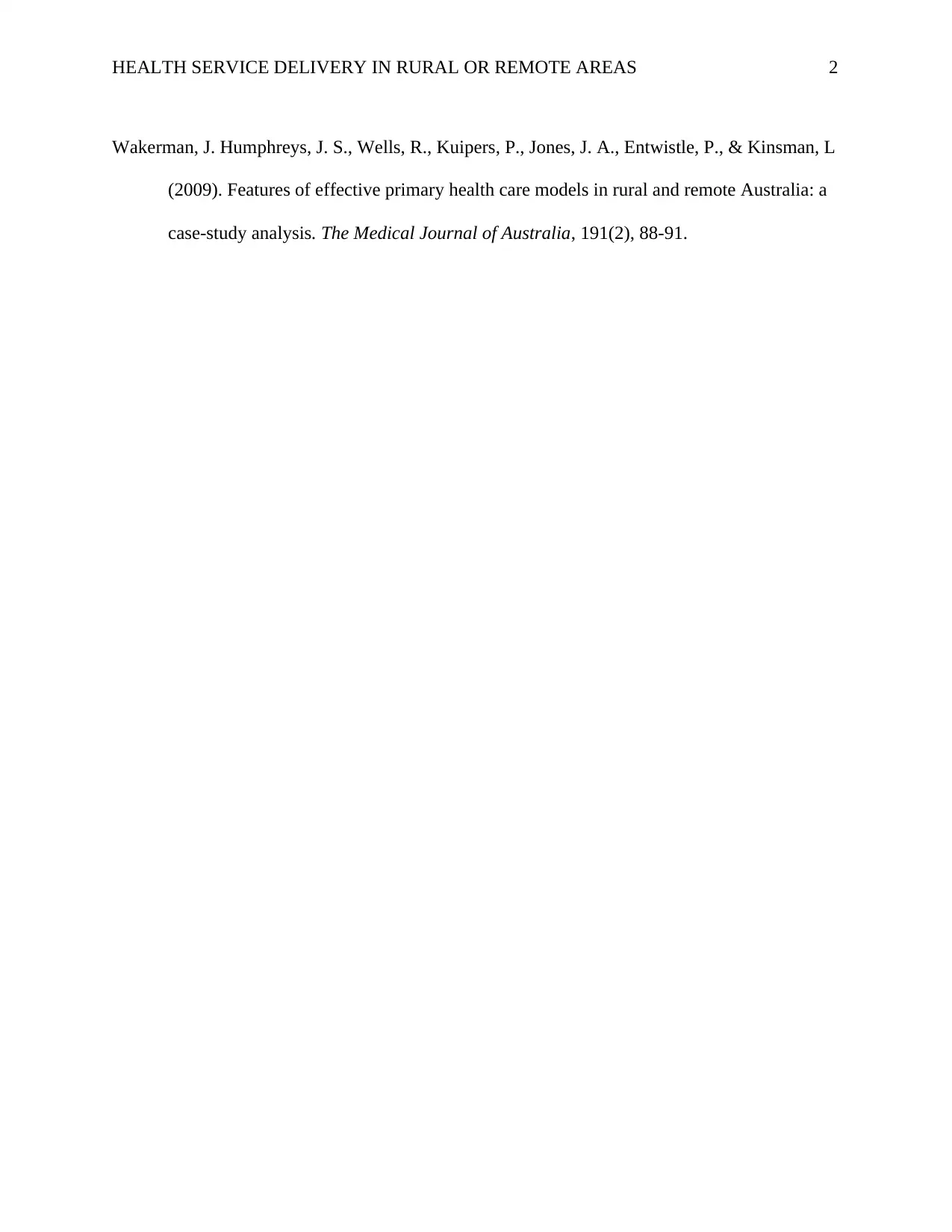
HEALTH SERVICE DELIVERY IN RURAL OR REMOTE AREAS 2
Wakerman, J. Humphreys, J. S., Wells, R., Kuipers, P., Jones, J. A., Entwistle, P., & Kinsman, L
(2009). Features of effective primary health care models in rural and remote Australia: a
case-study analysis. The Medical Journal of Australia, 191(2), 88-91.
Wakerman, J. Humphreys, J. S., Wells, R., Kuipers, P., Jones, J. A., Entwistle, P., & Kinsman, L
(2009). Features of effective primary health care models in rural and remote Australia: a
case-study analysis. The Medical Journal of Australia, 191(2), 88-91.
1 out of 11
Related Documents
Your All-in-One AI-Powered Toolkit for Academic Success.
+13062052269
info@desklib.com
Available 24*7 on WhatsApp / Email
![[object Object]](/_next/static/media/star-bottom.7253800d.svg)
Unlock your academic potential
Copyright © 2020–2025 A2Z Services. All Rights Reserved. Developed and managed by ZUCOL.




